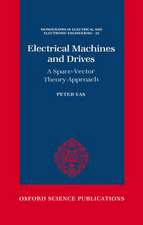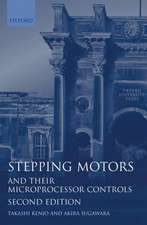The Field Orientation Principle in Control of Induction Motors: Power Electronics and Power Systems
Autor Andrzej M. Trzynadlowskien Limba Engleză Hardback – 31 dec 1993
| Toate formatele și edițiile | Preț | Express |
|---|---|---|
| Paperback (1) | 1815.03 lei 6-8 săpt. | |
| Springer Us – 23 feb 2014 | 1815.03 lei 6-8 săpt. | |
| Hardback (1) | 1656.08 lei 6-8 săpt. | |
| Springer Us – 31 dec 1993 | 1656.08 lei 6-8 săpt. |
Din seria Power Electronics and Power Systems
- 18%
 Preț: 944.19 lei
Preț: 944.19 lei -
 Preț: 487.37 lei
Preț: 487.37 lei - 20%
 Preț: 630.01 lei
Preț: 630.01 lei - 15%
 Preț: 648.56 lei
Preț: 648.56 lei - 15%
 Preț: 643.84 lei
Preț: 643.84 lei - 18%
 Preț: 1113.89 lei
Preț: 1113.89 lei - 18%
 Preț: 1120.99 lei
Preț: 1120.99 lei - 18%
 Preț: 950.33 lei
Preț: 950.33 lei - 18%
 Preț: 1981.53 lei
Preț: 1981.53 lei - 15%
 Preț: 638.43 lei
Preț: 638.43 lei - 18%
 Preț: 1660.95 lei
Preț: 1660.95 lei - 18%
 Preț: 940.87 lei
Preț: 940.87 lei - 15%
 Preț: 637.46 lei
Preț: 637.46 lei - 18%
 Preț: 949.55 lei
Preț: 949.55 lei - 18%
 Preț: 953.65 lei
Preț: 953.65 lei - 18%
 Preț: 953.97 lei
Preț: 953.97 lei - 18%
 Preț: 944.67 lei
Preț: 944.67 lei - 15%
 Preț: 634.32 lei
Preț: 634.32 lei - 18%
 Preț: 832.78 lei
Preț: 832.78 lei - 18%
 Preț: 945.30 lei
Preț: 945.30 lei - 18%
 Preț: 1239.85 lei
Preț: 1239.85 lei - 15%
 Preț: 642.18 lei
Preț: 642.18 lei - 18%
 Preț: 953.65 lei
Preț: 953.65 lei - 18%
 Preț: 1554.09 lei
Preț: 1554.09 lei - 18%
 Preț: 1657.03 lei
Preț: 1657.03 lei - 18%
 Preț: 951.47 lei
Preț: 951.47 lei - 18%
 Preț: 888.31 lei
Preț: 888.31 lei - 18%
 Preț: 1219.01 lei
Preț: 1219.01 lei - 18%
 Preț: 893.53 lei
Preț: 893.53 lei - 18%
 Preț: 942.94 lei
Preț: 942.94 lei - 18%
 Preț: 1110.24 lei
Preț: 1110.24 lei - 15%
 Preț: 641.85 lei
Preț: 641.85 lei
Preț: 1656.08 lei
Preț vechi: 2019.61 lei
-18% Nou
Puncte Express: 2484
Preț estimativ în valută:
316.93€ • 344.14$ • 266.22£
316.93€ • 344.14$ • 266.22£
Carte tipărită la comandă
Livrare economică 22 aprilie-06 mai
Preluare comenzi: 021 569.72.76
Specificații
ISBN-13: 9780792394204
ISBN-10: 0792394208
Pagini: 255
Ilustrații: XIX, 255 p.
Dimensiuni: 155 x 235 x 22 mm
Greutate: 0.52 kg
Ediția:1994
Editura: Springer Us
Colecția Springer
Seria Power Electronics and Power Systems
Locul publicării:New York, NY, United States
ISBN-10: 0792394208
Pagini: 255
Ilustrații: XIX, 255 p.
Dimensiuni: 155 x 235 x 22 mm
Greutate: 0.52 kg
Ediția:1994
Editura: Springer Us
Colecția Springer
Seria Power Electronics and Power Systems
Locul publicării:New York, NY, United States
Public țintă
ResearchCuprins
1 Dynamic Model of the Induction Motor.- 1.1 Space Vectors in Stator Reference Frame.- 1.2 Direct and Inverse Three-Phase to Stator Reference Frame Transformations.- 1.3 Voltage and Current Equations in Stator Reference Frame.- 1.4 Torque Equation.- 1.5 Dynamic Equivalent Circuit.- 1.6 Direct and Inverse Stator to Excitation Reference Frame Transformations.- 1.7 Motor Equations in Excitation Reference Frame.- 1.8 Examples and Simulations.- 2 Scalar Control of Induction Motors.- 2.1 The ? Equivalent Circuit of an Induction Motor.- 2.2 Principles of the Constant Volts/Hertz Control.- 2.3 Scalar Speed Control System.- 2.4 The ? Equivalent Circuit of an Induction Motor.- 2.5 Principles of the Torque Control.- 2.6 Scalar Torque Control System.- 2.7 Examples and Simulations.- 3 Field Orientation Principle.- 3.1 Optimal Torque Production Conditions.- 3.2 Dynamic Block Diagram of an Induction Motor in the Excitation Reference Frame.- 3.3 Field Orientation Conditions.- 4 Classic Field Orientation Schemes.- 4.1 Field Orientation with Respect to the Rotor Flux Vector.- 4.2 Direct Rotor Flux Orientation Scheme.- 4.3 Indirect Rotor Flux Orientation Scheme.- 4.4 Examples and Simulations.- 5 Inverters.- 5.1 Voltage Source Inverter.- 5.2 Voltage Control in Voltage Source Inverters.- 5.3 Current Control in Voltage Source Inverters.- 5.4 Current Source Inverter.- 5.5 Examples and Simulations.- 6 Review of Vector Control Systems.- 6.1 Systems with Stator Flux Orientation.- 6.2 Systems with Airgap Flux Orientation.- 6.3 Systems with Current Source Inverters.- 6.4 Observers for Vector Control Systems.- 6.5 Adaptive Schemes.- 6.6 Position and Speed Control of Field-Oriented Induction Motors.- 6.7 Examples and Simulations.










